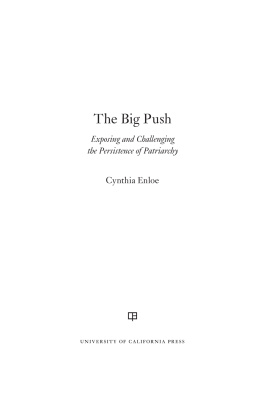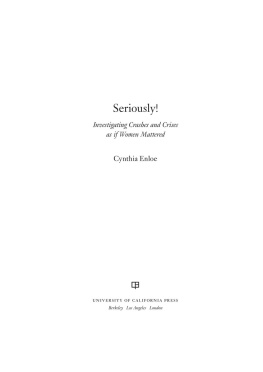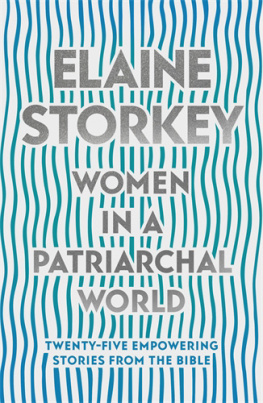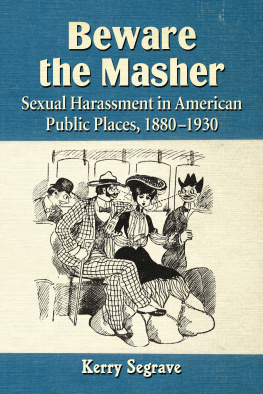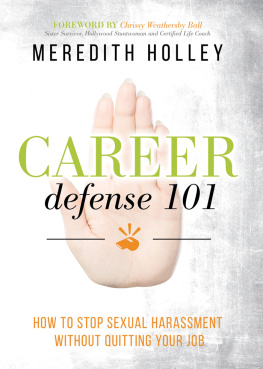PREFACE
Its Not All About Trump
Confession: I almost broke into a run to get away from the first person I heard utter the word patriarchy. We had been sitting at a picnic table on a lovely June afternoon. It was the lunch break at one of the early meetings on women and international development. It was all exciting; everyone was rethinking their experiences and trading new hunches. Then, over salads and drinks, someone said patriarchy. I fled (well, I think I just said I was going for a refill of my iced tea).
Patriarchy . It sounded so heavy, so blunt, so ideological. I wasnt interested in ideology, at least not in employing it myself. Instead, I was interested in nuances, in gritty realities, in the mundane workings of everyday sexism as it crept into policy and actions.
I was wrong. Patriarchy does not blot out nuance. Patriarchy does not overlook the mundane. As I began to understand, the concept of patriarchy is not a club with which to batter complexity into simplicity. Quite the opposite. Patriarchy is a searchlight, a concept that can enable us to see what we otherwise might miss: the connective tissues between large and small, subtle and blatant forms of racialized sexism, gendered misogyny and masculinized privilege.
Donald Trump may be the latest gift to those who seek to perpetuate patriarchy. His celebrity, his bizarre tweets, his outlandish claims, yes, even his orange hair, together serve to capture our attention. Today, from Brighton to Boston to Beijing, one can say Trump and provoke an immediate reaction. He hogs the stage.
It is risky, I think, to become so diverted by the patriarchal machinations of any outsized figure that we shrink our curiosity about less attention-grabbing, more insidious dynamics that are perpetuating patriarchal ideas and relationships. Patriarchy existed before Donald Trumpand before the rise of the newest nationalistic, racist, misogynist political partiesand, unless we together reflect on its mundane causes, it is too likely to exist after Trump has retired to his golf club and the latest right-wing parties have been temporarily defeated.
It has been with this worry in mind that I have crafted this book. Trump does not loom large on these pages. Yet it is precisely my concern that preoccupation with any super-scale political figures will divert us from self-reflection and deep investigation that has provided the motivation for writing it.
It was Jana Lipman, Vernadette Gonzalez, and the beloved late Teresia Teaiwa who nudged me to think afresh about my mothers and my road trips to American battlefields, and Ruri Ito and her splendid Japanese feminist friends who made sure I thought seriously about what it meant to visit Hiroshima as a tourist. Aye Gl Altnay and Andrea Peto have kept me thinking anew about World War I narratives and especially Turkish womens understandings of that deadly conflict. Jef Huysmans and Joo Nogeira were so generous in their mappings of international sociology as to accept the smallest of gestures by military wives as fodder for theorizing. For inviting me to reflect on my ongoing journey toward feminist awareness, thanks go to Pauline Yu, Candace Frede, Susan Bailey and Philippa Levine of the American Council of Learned Societies. Each of the five chapters that had its start as a journal article has been significantly revised and reframed to speak to this books core questions, but initially it took these encouraging editorial and scholarly colleagues to push each away from the dock.
Anne Marie Goetz, Nadine Puechguirbal, Madeleine Rees, Nela Porobi Isakovi, Elin Liss, Cynthia Rothschild, Sanam Naraghi-Anderlini, Lena Ag, Laura Mitchell, Isabelle Geuskens, Mikaela Luttrell-Rowland, Carla Afonso, Adriana Benjumea, Christine Ahn, and all the activists in Womens International League for Peace and Freedom, individually and together, have tutored me on the deeply gendered workings of the United Nations. They have made me aware of the globalized feminist efforts to challenge tokenism and, instead, make women, peace and security meaningful in the lives of women coping with and resisting wartime violence and post-war patriarchy.
For the accounts featured in this book, I am indebted to the thoughtful gender-curious research and careful reporting of Sohaila Abdulali, Sanne Terlingen, Hannah Kooy, Xinhui Jiang, Beatrix Campbell, Melissa Benn, Ghazal Zulfiqar, Maya Eichler, Anita Fabos, Denise Bebbington, Kristen Williams, and Valerie Sperling. At the same time, critical scholars and friends Ken Booth and Toni Erskine nudged me to revisit the implications of Carmen Miranda for todays international politics.
No author thinks or writes in isolation. Friends ask fresh questions, lead one to new sources of reliable information, and keep ones spirits up in order to stay actively engaged in these dark times. Among the feminist friends who have specifically nourished this book project have been Gilda Bruckman, Serena Hilsinger, Phi Pham, Laura Zimmerman, Margaret Bluman, Bob Benewick, Debbie Licorish, Amy Lang, Julie Abraham, Aleen Grabow, Lois Wasserspring, Annadis Rudolfsdottir, Sigga Ingadottir, Irma Erlingsdottir, and the members of the lively, politically savvy Sunday Afternoon Girlz Group and of our local feminist resistance huddle.
Icelands celebrated artist Karolina Larusdottir (simply Karolina to her Icelandic admirers) is the creator of the wonderful print featured here on the cover. When I first saw Karolinas image, it made me laugh out loud. Those stolid, besuited patriarchal men clearly dont know what is happening to them. Karolinas title, The Big Push , inspired this books own title. Julie Clayton and Ellen Sipple used their skills to create a digital version of The Big Push . I am grateful to Karolina Larusdottirs family and representatives for allowing me to use her art for the cover.
In these days of Trump, Brexit, and the upsurge of racist, misogynist right-wing parties, books, and newspapersthose things with pages that you can hold in your handsare gaining new readers, and regaining readers who briefly imagined the internet was a sufficient source for staying informed as civic actors. It turns out that books have not gone the way of the dodo and the fax machine. Booksfiction and non-fictioncan be the source of complex analysis based on careful, transparent research; books can allow us to enter into multi-faceted lives quite unlike our own; books can be absorbed slowly, read and reread; books can be shared and provide sparks for surprising conversations.

